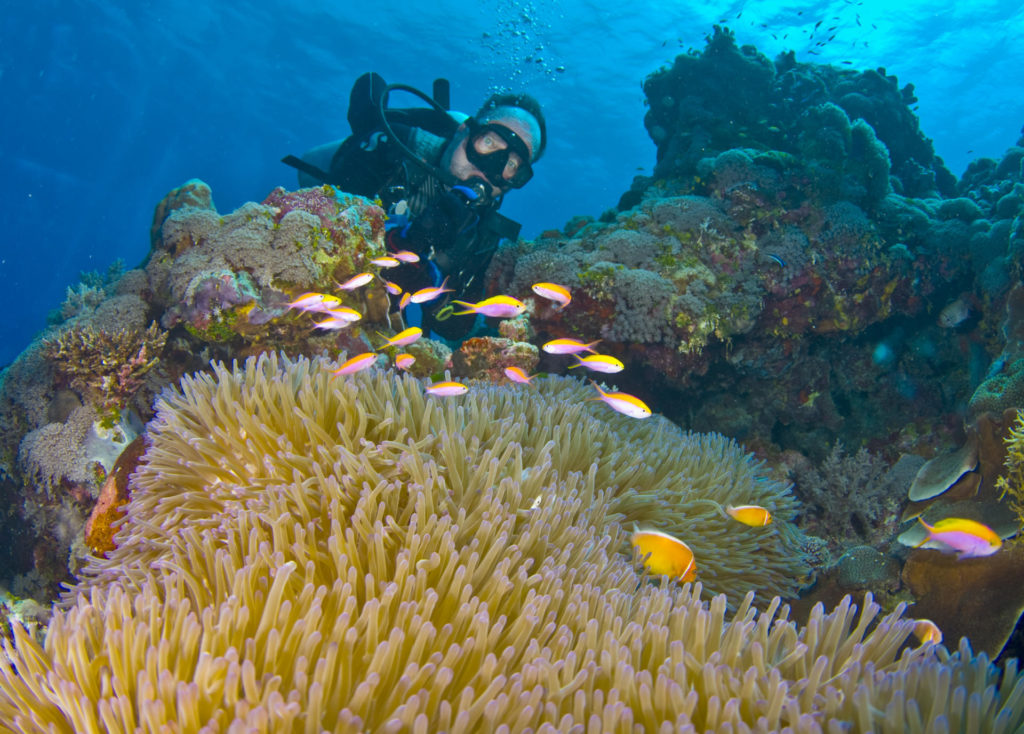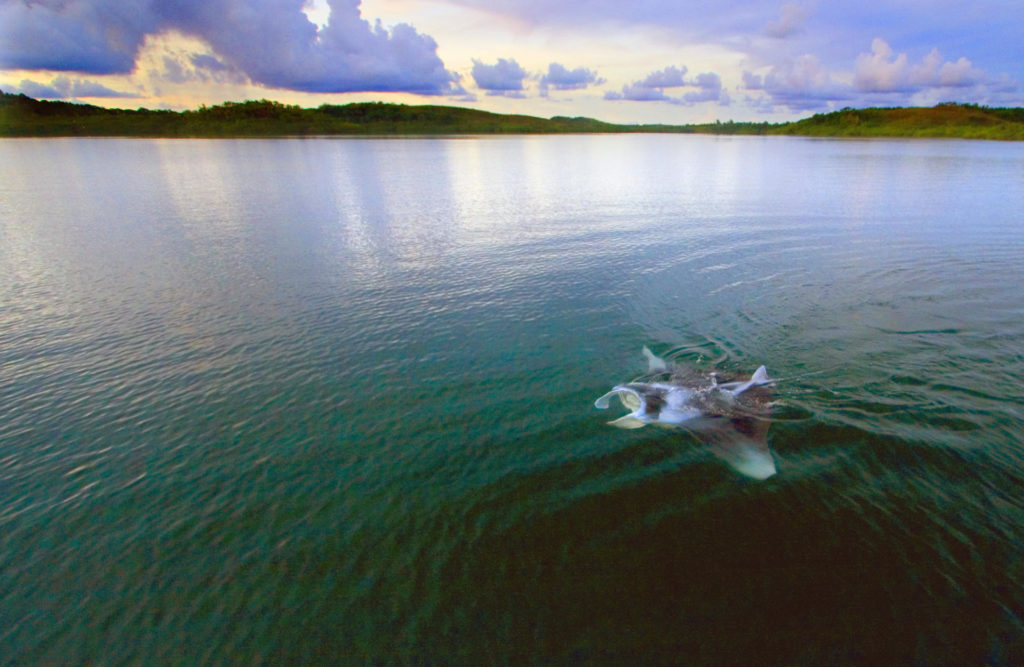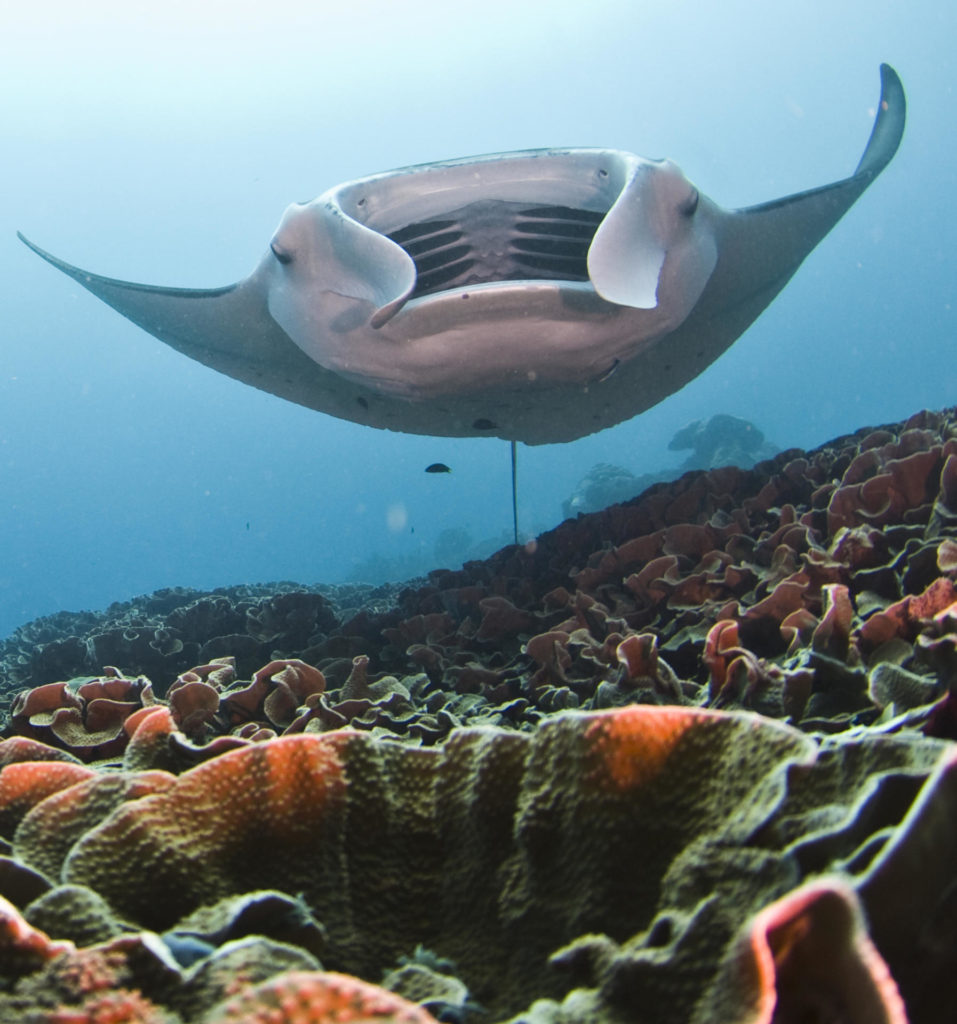I’m in Yap, Micronesia, home of some of the most remote reefs in the Western Pacific. As I prepare to scuba dive down to Vertigo Reef, I am not thinking about manta rays even though Yap is famous for a resident population of mantas which are graceful, plankton-eating members of the shark family. My attention is on their cousins, gray reef sharks, many of which are swimming around below.

As I descend, I see the pack out in the blue. There may be as many as 50 sharks in the blue void. Add to that some cruising blacktips and curious whitetips, and we have quite a shark stew. Who else will show up?
The island of Yap has lots to offer above and below the sea. A tiny, scenic and hilly isle, it is home to a people who still use giant stone discs as currency. Women still wear grass skirts, and men go about their villages in loincloths called thu’us. The reefs are also among the most remote, with families of manta rays and schools of sharks living in deep, canyon-like reef channels.
In the last decade, pioneers such as Bill Acker at Yap Divers (Web: www.mantaray.com) started to build a first class diving enterprise and open this special place to the world. Located in the western end of Micronesia, Yap is still considered remote by most standards. From Japan, one must fly to Guam and then catch one of the twice-weekly flights to this Micronesia outpost.
The lack of heavy development and a small population means little pressure has taken place on the coral reefs. Thus, Yap Island has developed and still has some of the healthiest corals in the Pacific.

While Yap is special for seeing mantas, some great new attractions include reef shark watching, a superb habitat for colorful, mating mandarin fish next to historic O’Keefe’s Island and some superb dropoff and hard coral sites. These attract everything from big schools of blackbar barracuda to the occasional school of scalloped hammerhead sharks.
Yap is a great place to watch the higher end of the food chain. The waters and reef areas hold gray reef sharks, silky sharks, silvertips, whitetips, leopard sharks and blacktips. On rare occasions even whale sharks, oceanic whitetips and tiger sharks are seen in these waters.
Vertigo Reef is becoming a premiere place to observe gray reef sharks cruising the blue. This is a reef where an occasional shark feed takes place. So the sharks show up for the heck of it when they hear a dive boat approach the reef. Large grays and the occasional blacktip move eerily in the water column. As many as a dozen sharks can be seen appearing in the blue out of nowhere. They may stay with divers for part or the entire dive along this sheer wall.
The gray reefs also can be found down the reef at a new site called Yap Corner. Located at the far northern end of the Miil Channel mouth, grey reefs, eagle rays, mantas and schooling jacks all come in here. Blackbar and sharpnose barracuda also come in for a look when the current runs.

On incoming high tide, divers can drift down the Grand Canyon of the Pacific, as 100-foot walls loom on both sides. Into the channel, there’s a cleaning station where sharks line up to be preened by small, fearless wrasse fish. At Manta Ridge, 60 juvenile gray reef sharks hang in shallow water, circling in a box canyon. The sharks are curious and come in close for divers to see.
Larger sharks also circle along the walls of this canyon near the Manta Ridge, and a morning sun brings clear sunlight basking rays down upon the menacing looking but curious sharks.
Closer to the town of Kolonia, the Crescent Reef has had some special shark sightings as well. Known for its resident school of barracuda and frequent cuttlefish sightings, lucky divers have had a school of scalloped hammerheads come in from the blue. These normally deep-water sharks sometimes come into the mouth of nearby Gabach Channel and can be seen in safe diving depths by the adventurous Yap scuba buff.
Add to this the schooling bumphead parrotfish at Yap Caverns, the scores of bigeyes and lionfish at Lionfish Wall and the breathtaking hard corals at the eastern island reefs, and a diver will find more and more to see and explore. Even the playful spinner dolphins off the southern tip and near Goofnuw’s Mini Wall can take hours of a diver’s time at sea.
A week can easily be spent exploring the island reefs, and there are some spots still unexplored. And if the reef possibilities start to run thin, one might even go looking for manta rays.

This is said in jest; of course, as the channels of Yap where the mantas are found are chock full of marine life and well worth a drift dive or two. But when you add mantas, eagle rays, sharks and turtles to the mix, it’s fascinating.
Yap has two types of diving. The outer reefs feature some of the healthiest and most diverse hard corals of anywhere in the Pacific. The eastern shore has large coral gardens with big coral formations and interesting small invertebrate marine life. The western side of the island features sheer dropoffs, a cavern system and big pelagic life, such as schools of barracuda, bumphead parrotfish and grey reef sharks.
The second is the channel diving. The inner channels of Yap are famous as a home for a resident school of manta rays. For best visibility, these are best dived with the high, incoming tide. At low tide, visibility can decrease as nutrients wash into the channels from the nearby mangroves, but the mantas still can be seen most of the time at cleaning stations. Yet, the most dramatic is to see them come in from the clear blue and approach ever so close.
While the mantas don’t live in these channels, they come in to get cleaned, to feed and to mate. Mating season, starting roughly in November and lasting until as late as April, is a superb time to watch manta interaction. Miil Channel is the most famous of the many channels around the island. The mantas form trains and do spectacular “aquabatics” as part of the mating ritual.
Divers with a true lust for adventure should continue to be amazed by Yap as it continues to unfold a seemingly endless supply of new sea secrets. A visit to the best sites and then a try at some of the new ones is a great way to see creatures big and small in the western Pacific on the magical isle of Yap.
Travel Info: Yap is the westernmost of the four states that comprise the Federated States of Micronesia. The many islands and atolls that make up Yap State stretch hundreds of miles across the open Pacific. Yap is 500 miles southwest of Guam, 300 miles northeast of the Republic of Palau, and 800 miles east of the Philippines.
Continental Airlines (Web: www.continental.com) serves Yap, with two flights a week from Guam (Tuesdays and Saturdays) and one flight a week from Palau (Sundays). The flight time from Guam is approximately one hour and five minutes, and the flight time from Palau is about 45 minutes.
Visitors need a valid passport and a return airline ticket to enter Yap and are allowed to stay of up to 30 days. Immigration rules vary by country, however, so please check with your hotel or tour operator prior to your journey.
Beyond the Blue
If you feel like a break from all the mantas and other marine life, Yap also offers some great kayaking in mangroves and around the vast inner lagoon. Explore the passages and go snorkeling at the inner coral reefs while gliding quietly over the sea.
Off-road biking is also good with many high trails and roads coursing the island. Finish your ride with a dip in the small, freshwater pit lake near the airport. And Yap has some nice hiking trails with interesting wildlife such as monitor lizards and the Yap monarch.

Manta Fest
The Fifth Annual Manta Fest Photo Festival takes place Aug. 27 – Sept. 11. If you are an aspiring underwater shutterbug, this is a great time to visit the island and rub elbows with some of the top underwater shooters in the world (including yours truly, Tim Rock), experience great diving and have lots of fun. This is an island-wide celebration involving hotels and dive shops. Web: www.mantafest.com.




